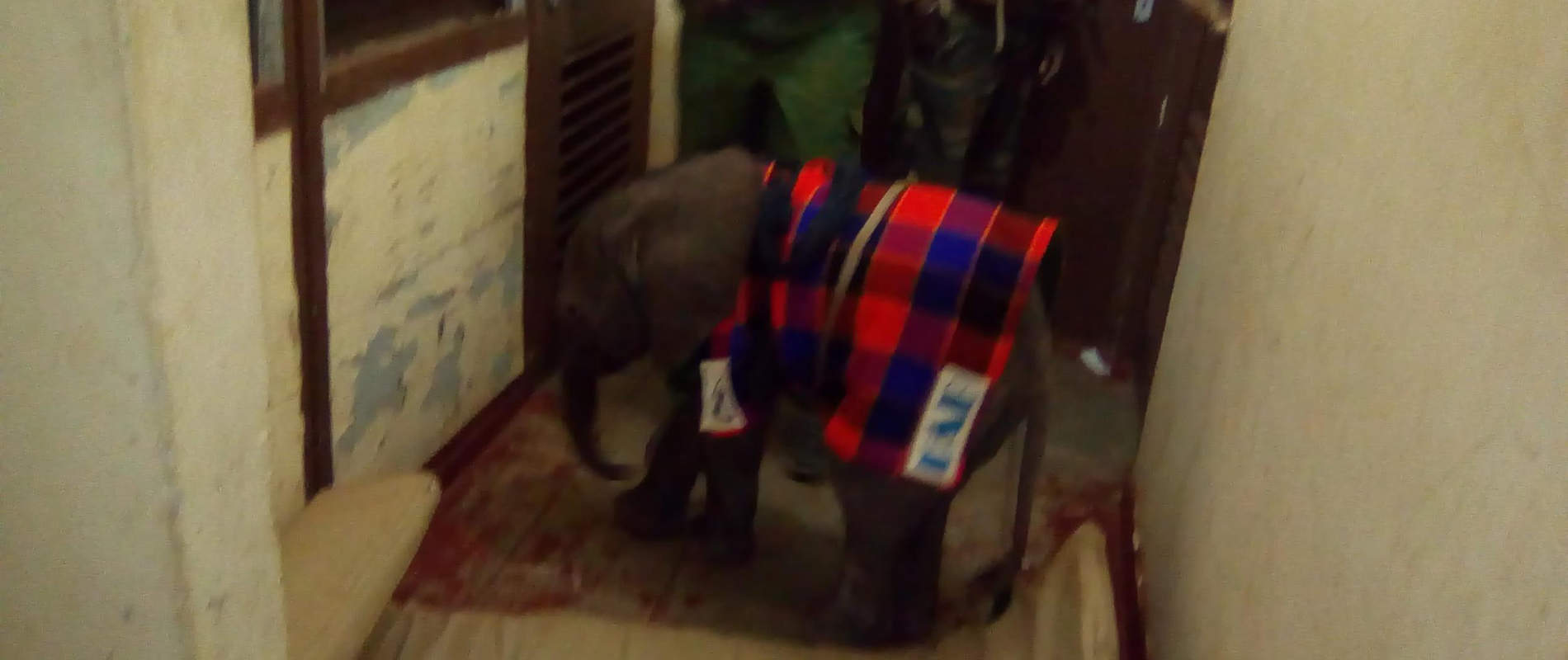Summary The year ends with regenerated foliage within the ecosystem
Summary
The year ends with regenerated foliage within the ecosystem. The start of the month was very wet making it inhabitable but towards the end of the month the opposite was experienced. Large herds of elephants, wildebeests and zebras which had sought refuge within the neighboring community conservancies are now exploring freely in the park savannahs and swamps as they feed and wallow. Hopefully the foliage present is going to sustain them for a long time and probably last to the next rainy season three to four months away.
The Amboseli Mobile Vet Unit was covering for the Tsavo Conservation Area Mobile Vet Unit because of annual leave. Several cases were thus attended to within the Tsavos as well as Amboseli. As animals are back within the proximity of the people, human illegal activities have been witnessed particularly snaring and spearing. It is also thought that the rescued baby elephant found abandoned could have been as a result of conflict as they got near the crop fields leading to the separation of the baby from the mother who fled the area. We hope the animals will keep off farms thus minimizing human-wildlife conflict in months ahead.
CASE 1 SECURITY DOG TREATMENT
Date: 3/12/2017
Species: Canine
Sex: Male
Age: Adult
Location: Ngulia Rhino Canine Unit Kennel; Tsavo West National Park
History
The sick canine was reported by Ngulia Rhino Sanctuary Officer In-charge as having wounds along its backbone causing pruritis. The dog was said to have been attended to on the same about a month earlier with slight improvement since then. It was said to be performing poorly in search duties within the rhino sanctuary. The Mobile Vet Unit visited the kennel for examination.

Observations
The dog had three circular wounds ranging between five and ten centimeters in diameter. Though showing signs of scab formation, they had also fresh edges due to constant pawing leading to bleeding and irritation from flies feeding from the wounds. When examined through palpation especially underneath they appeared to have a relatively hard dermis. Considering the area being tsetse infected area it was more likely that those were tentative chancre reaction due to tsetse bite. Upon inquiring about the epidemiology of the tryps infection it was established that the kennel has lost more than two dogs due to the same with recent one being early this year. The local reaction to the bite was more on unreachable locations on the back since the animal can deter any Tsetse bite elsewhere either by head, legs and or tail.
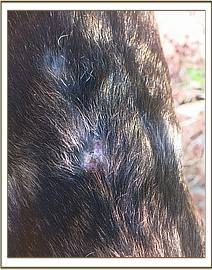
Treatment
Tentatively the canine was offered symptomatic treatment. Its prophylactic regime against tryps was varied hence the wounds were cleaned with Hydrogen Peroxide and Iodine followed with Tetracycline wound topical spray. This was recommended for three times a day till the wounds heal. Systemically it was injected with 450mgs Amoxicillin as broad spectrum antibiotic cover, 5mls Cyanocobalamine as metabolic stimulant and 6mgs Dexamethasone as anti-pruritic.
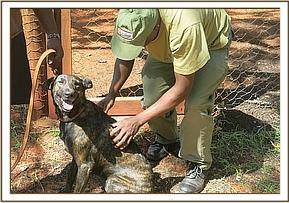
Prognosis
This is fair so long as the dog is withdrawn from the allergen and kept away from Tsetse infected areas
CASE 2 ZEBRA TREATMENT
Date: 7/12/2017
Species: Zebra
Sex: Male
Age: Adult
Location: Manyani Air Strip
History
Report of a lame zebra was made to the Amboseli Mobile Vet Unit by Deputy Commandant Manyani law enforcement academy. It was said to be lame on the right fore limb making it unable to keep pace with the rest of the group members. We immediately set out to treat and alleviate pain as we were holding on briefly for Tsavo Conservation Area Mobile Vet Unit which was on annual leave.
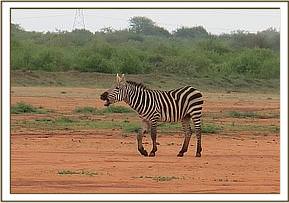
Observation
It was found alone near Manyani Airstrip static with fore right limb barely stepping. The fetlock had pus discharging wounds and could have possibly been caused by faulty snare which broke loose. It had slightly lost its weight due to ensuing stress. This male zebra was darted and eventually remaining still completely immobilized in seven minutes.


Treatment
Wounds were thoroughly disinfected with Hydrogen Peroxide after examining for any foreign object. It was then followed with Tincture of Iodine ensuring complete debridement was achieved. 10 grams of Cloxacillin antibacterial ointment was infiltrated into a canal penetrating at the medial aspect of the fetlock and then topically sprayed liberally by Tetracycline wound spray. Systemically it was injected with 15000mgs Amoxicillin, 30ml Cyanocobalamine and 10mgs Flunixin Meglumine at different muscle sites to cater for opportunistic pathogens induce appetite and reduce pain respectively.
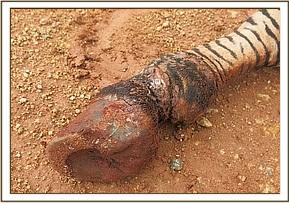

Prognosis
It had good prognosis because only soft tissues were the one involved.
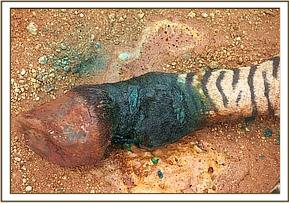
CASE 3 DOG TREATMENT REVIEW
Date: 7/12/2017
Species: Canine
Sex: Male
Age: Adult
Location: Kaluku
History
The canine by name Max was reported to be aggressive to allow stitches removal on its belly following a lump removal. Any attempt was met with a lot of aggressiveness thus warranting sedation to effect safe removal. The vet at Amboseli was reached out by Mr. Frans manager at Kaluku the day earlier and a response was done the following day.
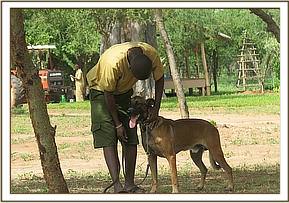
Treatment
A keen eye on the suture line depicted one tissue dehiscence at the middle of the sure line which was about fifteen centimeters long just caudal to sternum. Surrounding tissue depicted slight edema which did not warrant any diuretic. The suture line was cleaned carefully with swab and Hydrogen Peroxide and Iodine later. Topical Tetracycline spray was made to deter the flies. It was observed that the wound had pressure and still it was ten days post-surgery thus deemed to be early for sutures to be removed. This could have posed risk of suture line gaping because of observed pressure. They were advised to keep cleaning the wound as shown and review was tentatively scheduled for ten to eleven days later.
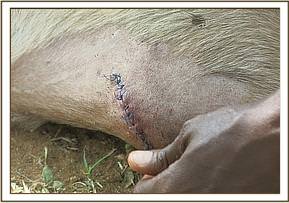

Prognosis
Good since there was no noted complication on the suture line.

Revisit
The case was reviewed again on 19/12/2017 with the view of removing the stitches. This could not be done without tranquilization. Same sedation and monitoring procedure was done like above and stitches removed carefully one after the other by cutting with surgical blade and pulling out.
CASE 4 SNARED ZEBRA
Date: 10/12/2017
Species: Zebra
Sex: Female
Age: Adult
Location: Manyani Gate; Tsavo East National Park
History
The snared zebra had been spotted on 1/12/2017 towards 1830hrs but the time was not sufficient to call in vet team. It had been spotted by DSWT Voi De-snaring Team based at Voi Tsavo East National Park Headquarters. The Vet Unit remained on standby on the following day. The vet team was informed of sighting and embarked immediately. The long dusty and rough journey took three hours and half up to Manyani Gate Tsavo East National Park.
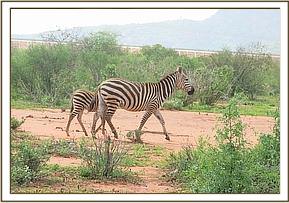
Examination
The plain single wire was lodged on the neck just behind the mandibles. It was barely tight causing no significant edema or strangulation. It was a nuisance though because it was dangling downwards in front of forelimbs and could be stepped on as animal ambulated round and more so due to bush entangling. The snare wire was not strong enough to ‘immobilize’ the animal because it seemed the snare was meant for small game like small and medium size antelopes for game meat.


Treatment
The snare wire had not caused local edema because it was barely tight. The snoop was loosened using hands and taken off the neck. The animal was injected with broad spectrum antibiotic inform of 15000mgs Amoxicillin and metabolic stimulant as 50ml Multivitamin in different muscle sites. 8mgs Ivermectin was administered subcutaneously as anthelmintic. All these were geared towards taking care of any post darting opportunistic pathogen.
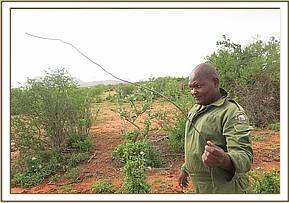

Prognosis
The animal is in no danger because the snare had not caused any traumatic wound
CASE 5 TREATMENT OF AN ELEPHANT
Date: 12/12/2017
Species: Elephant
Sex: Male
Age: Adult
Location: Maisuyati, Kuku Conservancy
History
The speared elephant was spotted by Big Life Foundation Rangers who reported the matter to DSWT Operation Center Kaluku who eventually informed the vet in Amboseli.
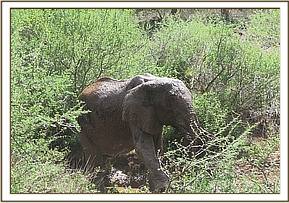
The vet followed up the matter with Big Life Foundation Operation Centre who directed the vet unit to exact location where the elephant was. Immediately the vet unit set out and at the scene two vehicles kept assistance with BLF rangers at close range just in case of need. The elephant was found alone walking sluggishly and then started mudding at a shallow water pan. It seemed weak from far and was reported not to be aggressive as would be the expectation. A dart was made prior to close range observation so as not to stress the frail candidate.
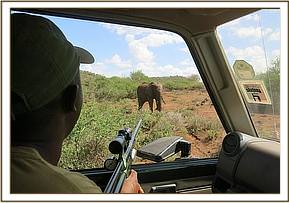

Examination
The penetrating wound was parallel to the spine and about ten centimeters. It was about three to four days old exhibiting bloody edges at the mid right chest area. It was pronged for any foreign object using long forceps all in vain. It was about thirty centimeters deep just under the skin track leading anteroventrally and beginning to exude foul smell. Surprisingly there was obvious air rushing out through the wound coinciding with the inhalation i.e. expansion of the thorax cavity upon breathing in. This was not clear whether it came from pleural cavity or just under the skin.
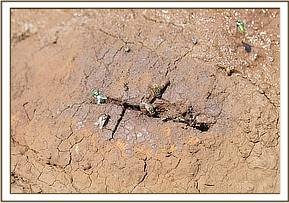

Treatment
The wound was cleaned thoroughly using Hydrogen Peroxide and Iodine. 10 grams Cloxacillin antibacterial ointment was infused into the canal followed with liberal packing of green wet clay to encourage tissue regeneration and reduce dead space obscuring also the wound from ox peckers and flies. It was followed with generous topical spray of Tetracycline wound spray. The animal was injected with broad spectrum antibiotic inform of 30000mgs Tetracycline, metabolic stimulant as 100ml Cyanocobalamine and anti-inflammatory as 50ml Flunixin Meglumine in different muscle sites.
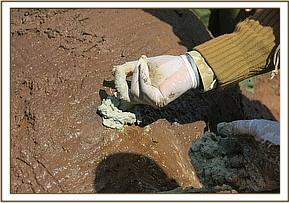

Prognosis
The animal seemed frail and appeared to be severely affected by the spear wound with possibilities of having penetrated into pleural cavity. This informed guarded prognosis pegged on the animal
CASE 6 ELEPHANT DE-SNARING
Date: 24/12/2017
Species: Elephant
Sex: Female
Age: Calf
Location: Taita Ranch
History
The snared baby elephant report was made to Amboseli Vet by the DSWT Chopper Pilot at the evening of 23/12/2017. Arrangement was done to remove the snare on the following morning because the sighting was past five in the evening and there was no amble time for exercise.
Treatment
Quickly in order to ensure clear air way the winch wire was severed using wire cutter easing the strangulation enabling the candidate to be stabilized easily. The snare had not caused traumatic wound hence the snare pressure line was cleaned with Hydrogen Peroxide and Tincture of Iodine first on left side and then right side after turning it over. It was sprayed topically with Tetracycline wound spray and dart wound infiltrated with 5grams Cloxacillin ointment to prevent abscess formation. It was covered systemically with 75000mgs Amoxicillin, 20ml Multivitamin and 50mgs Flunixin Meglumine at different muscle sites.
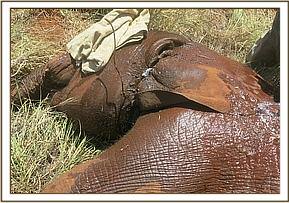
Reversal
This was achieved by use of 12mgs Diprenorphine administered through superficial ear vein after eight minutes after being fully immobilized. It staggered once and gained feet thereafter and walked away. It was forced to face the direction where the mother was about four hundred meters away on an open plain. It picked the mothers scent as it followed the trail. Efforts to bring the mother towards where the calf was were futile even with the ground vehicle and chopper. She was adamant and turned aggressive smashing the vehicle as she tried to injure the driver resulting in breaking her right ivory tip. The driver’s door was left severely dented with a broken side mirror. It was hoped that they would rejoin at some point because the calf was on the trail of its mother. Meanwhile the security team of Taita Ranch was deployed to keep watch and raise alarm in case they fail to join in twenty-four hours or if calf is spotted alone so that a rescue can be organized.
Prognosis
Good as there was no resultant traumatic wound and edema was almost negligible.
CASE 7 ELEPHANT RESCUE
Date: 27-28/12/2017
Species: Elephant
Sex: Male
Age: Calf
Location: Kimana Sanctuary
History
A young elephant baby was reported by the residential rangers while on late afternoon patrol to have been found lying on left lateral recumbence with no elephants within the area. They searched the area for any elephant presence but all in vain. They informed the Vet Unit which quickly moved to rescue the abandoned little young one before the night fell.
Rescue
It took twenty minutes of rough road drive to where the baby was. It was found under rangers’ guard. It was half an hour to seven in the evening and quick rescue plan had to be made. It was wrapped with a towel to keep it warm. DSWT CEO was reached out for possible aerial support and necessary advice. Meanwhile the baby was disturbed by what appeared to be hunger and or dehydration. Two litres of bottled drinking water was supplied and filled into a suckling bottle from which the calf suckled.
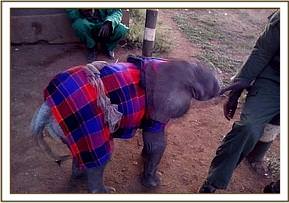

The CEO instructed that the calf would be picked in the following morning by DSWT Helicopter because it was already at night fall. Meanwhile the baby was carried to Amboseli Park Headquarters where the vet hosted it overnight under monitoring. All communications were made between the chopper pilot and the Vet to see to it that the baby is picked safely and early enough the following morning so that the most needed tender loving care is instituted in the nursery in company of other orphans soonest possible. The chopper landed at Amboseli Headquarter football field. The calf had been driven to the field which was a hundred meters away at 6.30am.
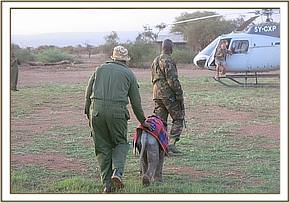

Everyone got to a safe distance from the chopper following the pilots’ instructions and off it went up with estimated time for DSWT Nursery at Nairobi of one hour. The calf was strong all through the rescue adventure with no noticeable complication and it was hoped that it could adapt successfully at the orphanage. The pilot called after fifty-seven minutes post take off from Amboseli to inform that the baby was safe at the nursery. All from Amboseli wished it good luck in life ahead.
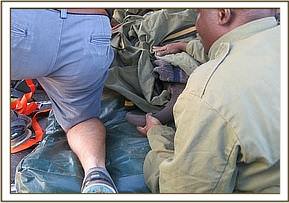

Prognosis
It was given fair prognosis considering the smooth rescue adventure witnessed and good health demeanor observed.
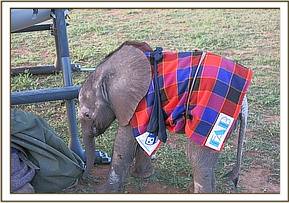
CASE 8 STUCK BUFFALO
Date: 28/12/2017
Species: Buffalo
Sex: Male
Age: Adult
Location: Amboseli National Park
History
A stuck buffalo was spotted by several tour drivers on their way to Observation Hill and one after the other called for help through the Park Tourism Warden. It was the Warden who informed the Vet Unit of the incidence and an immediate response was mounted.


Rescue
The emaciated bull was found on sternal recumbence. It was not immediately established for how long it had stuck but it was assumed to have gotten stuck the previous night. It got startled as we drove to the swamp edge where it was. It was about ten meters from the edge, but the mud/silt thickness was heavy hence it could not wade out. A rescue was achieved by use of a long rope anchored on the vehicle. It was pulled out quickly taking care not to dip nostrils into the mud or cause skin abrasions.
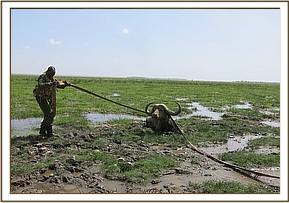

Because there was no drug used to calm the animal, one needed to quickly get the loop off the poll before the animal got up. After taking off the loop it was placed on sternal recumbence and left for some few minutes to gain strength. It was seen attempting to get on all fours but the hind limbs were still numb. It was left in the sun bath eventually got up. We drove away to reduce stress and left it alert and on sternal recumbence.
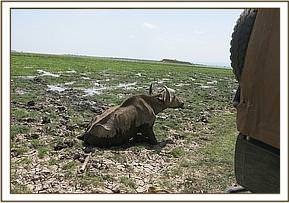

Prognosis
Considering the poor health status with severe emaciation it was given a guarded prognosis
CASE 9 ZEBRA TREATMENT
Date: 28/12/2017
Species: Zebra
Sex: Male
Age: Adult
Location: Amboseli National Park
History
The zebra was spotted by the Vet Unit while on their way back from rescuing a stuck buffalo. It was seen completely still on left lateral recumbence with three ox peckers on its body. This attracted our curiosity.
Observation
The left fore fetlock joint had blood oozing wounds both on lateral and medial aspects, the right hind limb had a discharging wound at the distolateral to tibiometatarsal joint, the left hind limb had a transverse wound at mid metatarsus anteromedially while the rest of body had skin abrasions of various sizes more so on the neck. It appeared that it had suffered territorial fight wounds from another stallion. All wounds appeared fresh.


Treatment
All wounds were cleaned with Hydrogen Peroxide followed with Tincture of Iodine. Topically they were sprayed liberally with Tetracycline wound spray. It was injected with 20000mgs Tetracycline, 500mgs Flunixin Meglumine, 20ml Multivitamin all in different muscle sites followed with 80mgs Ivermectine under the skin. These were aimed to take care of any secondary bacterial infection, reduce pain, instill appetite and clear endo and ecto parasites respectively.
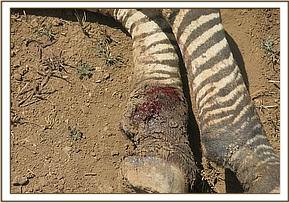

Reversal
It was achieved by use of 12mgs Diprenorphine injected into jugular vein after ten minutes of complete mobilization. It was up in two minutes and walked away depicting less lameness than initially.
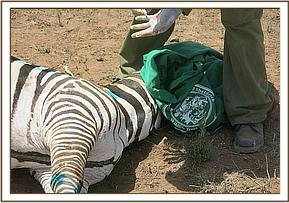

Prognosis
Good since the wounds were fresh and the animal was still in good body condition.
